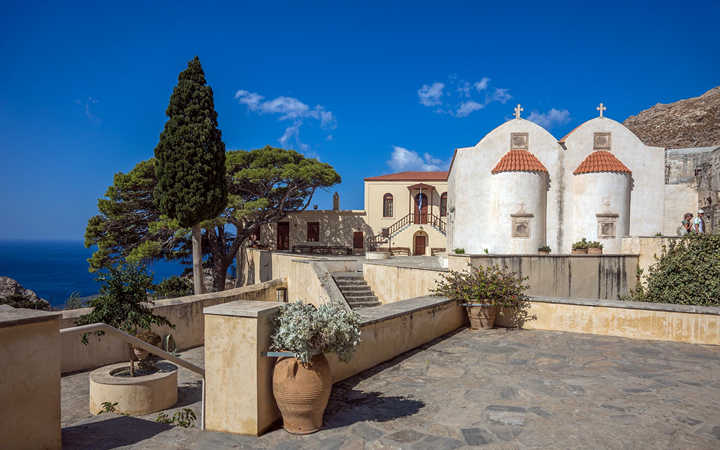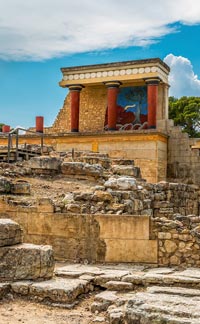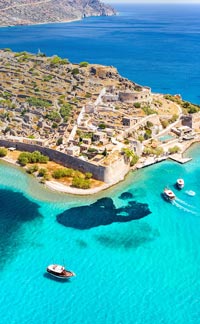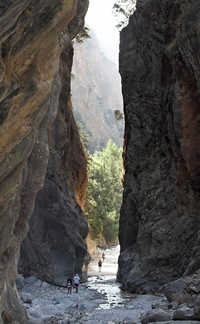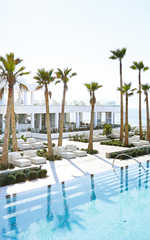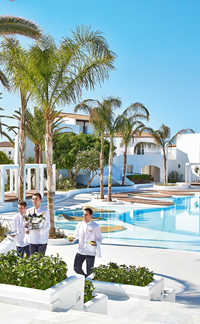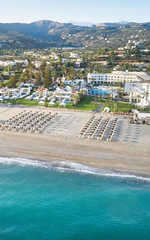Preveli Monastery, about 200 meters above sea level, sits in a fold between 2 rounded-top, 400-meter. Its multi-level stone-paved terrace looks out at some lovely wind-sculpted trees and shrubs, a few rocky outcrops, and, 700 meters away, the dark blue waters of the Libyan Sea. It is a view to die for.
The monastery, on the island's south-central coast, is somewhat in the middle of nowhere, but it's so beautiful that it's worth the trip. The official name for it is the Holy Stavropegic Preveli Monastery of St. John the Theologian, "stavropegic" meaning the monastery gets its marching orders directly from the Ecumenical Patriarch of Constantinople (sort of the Orthodox pope), instead of a local Bishop, although it is still in certain aspects under the authority of a local Bishopric.
The monastery is made up of two groups of buildings; the Kato (lower)Monastery of St. John the Baptist, which is in ruins, and the functioning, Upper, or Pisso (back) Monastery of St. John the Theologian.
History
The Kato Monastery was probably built during the 11th century under the auspices of the then ruling Byzantines. (Around the turn of the first millennium several monasteries were founded on Crete's south coast.) The later iteration of the monastery was founded by a local feudal lord named Prevelis.
The monastery's history is one of both education and of implementing Crete's desire for freedom from various overlords, particularly the Ottoman Turks, who, when they took over the islands from the Venetians in 1649, destroyed Preveli along with a number of other ecclesiastical sites around Crete.
When the Turks took over Crete, as was the case all over Greece, it was left up to the church to preserve Greek language and history, and a network of "kryfa scholia," or secret schools, sprang up. Classes were usually taught after dark to ensure safety. Preveli was a leader in this movement of preservation of Greek culture and education, founding, funding and otherwise supporting a number of secret schools in the region.
Later on, as Greece struggled in its War of Independence, which began in 1821, several of the abbots of the monastery aided and abetted the rebels, sometimes to their, the abbots, detriment. While a great deal of mainland Greece achieved independence by 1829, Crete struggled on under the Ottoman yoke until the end of the century, a time that was punctuated by sporadic uprisings. Preveli aided in these as well, going so far as having its monks participate in some of the local battles.
It was during the second revolution, known as the Cretan Uprising, which began in 1866, that the Kato Monastery was put to the torch, on July 7, 1867, by 8,000 Turks under the leadership of Resit Pasha. The Pisso Monastery was saved by the monks, and continued to play a role in the Uprising until it ended in 1869.
In the late 1890's the monastery's School of the Holy Spirit was upgraded to college status, and has been an important educational institution ever since. During the Balkan Wars in the 1912, when Thessaloniki and northern Greece were finally able to achieve independence from Turkey and reunification with Greece, several monks went up north to fight. The following year, northern Greece was re-united with Greece, and newly independent Crete voluntarily united with Mother Greece.
During WWII, the monastery aided freedom fighters against the Nazis with supplies, and helped shepherd fleeing New Zealand, English, and Australian soldiers off the island, allowing them to escape to the Middle East. The Germans, aware of the prominent role of the monastery in helping the Allies flee, vandalized it, destroying its furniture, the monks' vestments, and its olive oil and wine stocks.
Museum
There is a small museum on the grounds, featuring a number of fine examples of the art of the icon from the 17th-19th centuries. In addition, there is a selection of ecclesiastical garments, vessels and a collection of heirlooms, including gold and silver-plated gospels, gold plated chalices, and metal seals.
Preveli Beach
Not far from the Monastery is Preveli Beach, where the Megapotamos (Big River) flows into the sea through a small palm forest. It's one of the only rivers in Crete that do not dry up during the summer. The palm forest, one of only two of its kind in Crete, unfortunately burned in 2010, but is rapidly regenerating itself. The trees, although scorched by the fire, weren't destroyed, and are sprouting new palm branches at a rapid rate.
The river forms a lagoon at its meeting place with the sea. It's one of the loveliest beaches on Crete, with the lush vegetation and palm trees watered by the river. The beach is of white sand, and the waters of the Libyan sea are exceptionally clean. There are no amenities at the beach, so what you bring is what you use.

